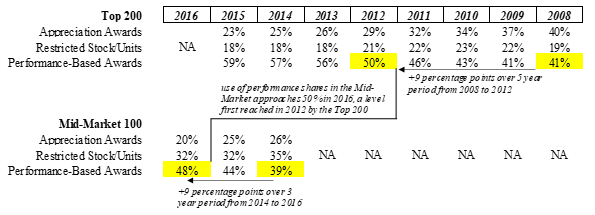-
Email
Linkedin
Facebook
Twitter
Copy Link

Loading...
On Governance is a series of guest blog posts from corporate governance thought leaders. The series, which is curated by the Governance Center research team, is meant to serve as a way to spark discussion on some of the most important corporate governance issues. On June 11, 2018, SEC Commissioner Robert Jackson highlighted the practice of executives more likely to sell stock following a stock buyback. Commissioner Jackson’ analysis shows that “twice as many companies have insiders selling in the eight days after a buyback announcement as sell on an ordinary day.” The implication is that executives take advantage of the stock price bump-up to sell shares. His remedy is two-fold: (1) SEC will review the safe harbor rules for insiders selling shares and (2) implore boards and compensation committees to review this practice. A stock buyback is when a company purchases its own stock, either on the open market or directly from its shareholders. A buyback is also known as a share buyback or stock repurchase. Similar to a dividend, a buyback is a way to return capital to shareholders. While a dividend is effectively a cash bonus amounting to a percentage of a shareholder's total stock value, a stock buyback requires the shareholder to surrender stock to the company to receive cash. Those shares are then pulled out of circulation and taken off the market, thus having a similar effect of returning capital to shareholders. Buybacks are a relatively new concept. Prior to 1982, they were not common. In fact, they were illegal throughout most of the 20th century because Buybacks were considered a form of stock market manipulation. In 1982, the SEC passed Rule 10b-18, which created a legal process for executing a buyback. Today, in 2018, more companies than ever are buying back stock. The increase in buybacks has been fueled by The Tax Cuts and Jobs Act passed on December 27, 2017, which substantially lowered the corporate income tax rate as well as repatriation tax that encouraged money held abroad to be brought back to the United States. There are three main types of buybacks: cash-based, loan-based and a combination of cash and equity. The effect of a buyback on an executive incentive program and pay levels will depend on a variety of factors and is specific to each company and its unique incentive program. In general, there are many positive aspects of buybacks, which center on increasing stock price and thus shareholder value: Despite these positive attributes, there has been much criticism surrounding buybacks, particularly surrounding their potential to increase executive compensation levels regardless of the operational success of the company. This is particularly true with the recent reduction in corporate income tax rates. The underlying business model has not really changed or improved, but there is extra cash generated due to the tax savings. Buybacks directly influence many of the financial ratios used as performance metrics in executive LTI plans. As discussed previously, Buybacks can boost EPS, ROE, ROA, ROIC, or stock price. While growth in pay levels through the increased value of stock holdings and LTI payouts may benefit executives, there is bound to be criticism from investors, employees, and political factions. A key connection between buybacks and executive pay is EPS. A buyback will reduce the number of a company’s outstanding shares and thereby increase the earnings per share metric. EPS is often a key benchmark for an executive’s performance-based pay – particularly in LTI programs. In addition to EPS, a buyback also impacts other parts of the financial statement. On the balance sheet, a share repurchase will reduce the company’s cash holdings, and consequently its total assets base, by the amount of the cash expended in the buyback. The buyback will simultaneously also shrink shareholders' equity on the liabilities side by the same amount. As a result, performance metrics such as ROE ROA and ROIC typically improves following a buyback. Like EPS, each of these capital efficiency measures are commonly used in executive LTI plans. Another issue when it comes to executive compensation is that a buyback generally occurs during an LTI award’s performance period, and there is no corresponding adjustment to the performance goals to offset the effect of the Buyback. So, it can be said that a Buyback gives the executives a head start in achieving their performance goals. At a time when institutional investors frequently challenge whether performance targets are rigorous enough, critics of buybacks believe senior executives should not receive larger pay packages simply for reducing the number of shares outstanding. There is also concern that while buybacks they may boost stock prices in the short term, they can deprive companies of capital necessary for creating long-term growth. A Closer Look at Buybacks and Executive Pay It is indeed true that executives in the United States will receive larger incentive payouts when measures like EPS, ROE, ROA, ROIC, and stock price show improvement (financially engineered or not). Today’s executive pay packages 1) include a significant portion of LTI awards, and 2) rely heavily on LTI awards with performance conditions (versus time-based awards). A recent Gallagher study[1] showed that a majority of executive LTI awards at large-cap companies are tied to performance measures, including stock-price- or EPS-related measures. Among the Top-200 companies by market capitalization, performance-based LTI awards first averaged 50 percent of the total LTI grant value back in 2012. By 2015, performance-based awards had increased to 59 percent of the total LTI grant value. Following closely behind top companies, we found that midmarket companies have also moved towards LTI programs focused on performance-based awards[2]. In 2016, performance-based awards made up 48 percent of the total LTI grant value among these companies, up from just 39 percent in 2014. This midmarket sample includes 100 companies selected at random from the Russell 3000 universe and included companies across multiple industry sectors with revenues between $1 billion and $5 billion (nonfinancial companies) or assets between $1 billion and $10 billion (financial companies). See Figure 2. Boards of directors continually search for ways to increase shareholder value. This process will sometimes result in a decision to buy back company stock. Care should be taken to avoid enrichment of executive pay packages as a result of the buyback. The selection of performance measures and corresponding performance levels can be one of the most difficult aspects of designing an incentive compensation program for executives. Scrutiny may be further complicated as buybacks continue to increase in prevalence. Companies should be cautious when selecting performance measures that can be manipulated by financial engineering such as buybacks, equity to debt swaps and other re-financings, and be ready to explain the reasoning behind such choices in the annual proxy statement. The views presented on the Governance Center Blog are not the official views of The Conference Board or the Governance Center and are not necessarily endorsed by all members, sponsors, advisors, contributors, staff members, or others associated with The Conference Board or the Governance Center.

FIGURE 2. Mid-Market Companies Follow the Large Company Trend of Relying on Performance-Based LTI Awards
Conclusion
80 Years of Corporate Citizenship & Philanthropy Leadership
November 27, 2023
How CEOs and Boards Can Enhance Digital Trust
April 04, 2023
Reaching Net-Zero Emissions
January 31, 2023
First 2022 Racial Equity Audit Proposals Successful
March 22, 2022
